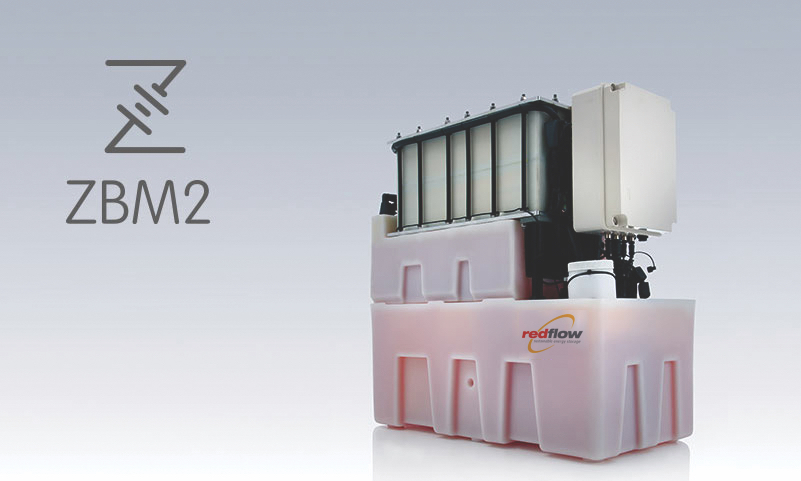It has been a busy week for Redflow. The zinc-bromine battery supplier has signed a collaboration agreement with Chinese zinc-bromine flow battery company ZbestPower to supply a 100 kwh energy storage solution for a solar and electric vehicle smart grid project.
Redflow’s batteries will be incorporated in a 1 MWh energy storage system and coupled with 66 kW of solar to power a carport with 18 EV fast charging points. With the help of a smart energy management system, the energy storage system will allow the Haidong Transportation Group to charge its electric vehicles with cheap solar energy and analyze various energy storage technologies on site.
The project, which marks Redflow’s entry into the Chinese battery market, is sponsored by the China National Energy Bureau and managed by ZbestPower. The Redflow energy storage solution, containing 10 of its ZBM2 zinc-bromine flow batteries, will be provided for an initial six-month deployment, which is expected to commence in early June 2019. Redflow aims to use this as “a key springboard to develop further projects in China”.
“Energy storage in China is a large strategic market opportunity for Redflow,” Redflow CEO Tim Harris said. “With China transitioning to greater use of renewable energy, The China National Development and Reform Commission has called for greater investment in flow batteries that is leading to a surge in projects focused on flow battery solutions. Redflow is well-placed to address these opportunities.”
For Beijing-based ZbestPower, the collaboration with Redflow represents an opportunity to deepen its understanding of the potential for ZBM2 batteries in China. “Flow battery technology has been identified as a vital part of China’s energy storage future,” said ZbestPower CEO Luke Lu.
New partner
In other news, Redflow has come together with green energy system integrator Soul Energy and is set to provide batteries for the first in a series of infrastructure projects the New Zealand-headquartered company is planning to deploy throughout Australasia.
The partnership with Redflow has enabled Soul Energy, a provider of technology infrastructure solutions, to focus on key verticals, including telecommunications, utilities, agriculture and commercial as well as off-grid communities.
During the past six months, the two companies were working together to develop a standardized energy storage solution based on Redflow’s ZBM2 batteries, which provide a compelling technical and commercial proposition for these sites. For the first project, Redflow is expected to supply 200 batteries.
The project is still at an early stage, but is likely to commence with an initial small order in June. Once the first customer awards the head contract to Soul Energy, Redflow will finalize commercial battery supply terms which will include project staging and delivery schedules.
In its earlier oversea projects, Redflow supplied $1.6 million worth of its 10 kWh ZBM2 batteries to Fiji to power a new local digital television network. The systems were shipped from its Thai facility and installed by New Zeland’s Hitech Solutions. It also deployed 10 of its zinc-bromine flow batteries coupled with three li-ion batteries to store solar generated power in a far-flung village in northern Thailand.
In 2017, the ASX listed redox-flow supplier relocated its manufacturing facility to Thailand, which has resulted in lower fixed costs. The company reported the loss after income tax stood at about $11.9 million in FY18, down from $12.9 million in the previous fiscal year.
Marketed as ZCell and ZBM2, Redflow 10 kWh zinc-bromine flow batteries are designed for high cycle-rate, long time-base stationary energy storage applications in the residential, commercial & industrial and telecommunications sectors, and are scalable from a single battery installation through to grid-scale deployments.
This content is protected by copyright and may not be reused. If you want to cooperate with us and would like to reuse some of our content, please contact: editors@pv-magazine.com.









By submitting this form you agree to pv magazine using your data for the purposes of publishing your comment.
Your personal data will only be disclosed or otherwise transmitted to third parties for the purposes of spam filtering or if this is necessary for technical maintenance of the website. Any other transfer to third parties will not take place unless this is justified on the basis of applicable data protection regulations or if pv magazine is legally obliged to do so.
You may revoke this consent at any time with effect for the future, in which case your personal data will be deleted immediately. Otherwise, your data will be deleted if pv magazine has processed your request or the purpose of data storage is fulfilled.
Further information on data privacy can be found in our Data Protection Policy.